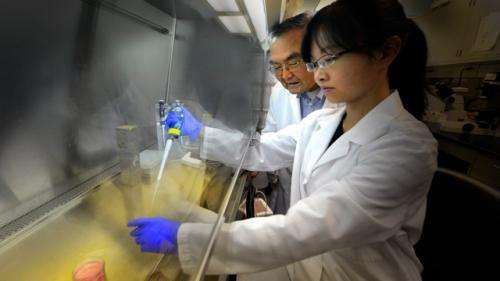Biological fat with a sugar attached essential to maintaining the brain's supply of stem cells

Fat and sugar aren't usually considered healthy staples, but scientists have found that a biological fat with a sugar attached is essential for maintaining the brain's store of stem cells.
Neural stem cells help the brain develop initially, then repopulate brain cells lost to usual cell turnover as well as to a trauma or malady, such as a head injury or stroke.
While the cell population and activity decrease as a natural part of aging, scientists at the Medical College of Georgia at Georgia Regents University are studying how neural stem cells are normally maintained with the long-term goal of helping the supply stay robust despite aging as well as infirmity.
They have discovered that in mice missing the sugar containing lipid ganglioside GD3, neural stem cells have a dramatically impaired ability to self-renew, said Dr. Robert K. Yu, MCG neuroscientist and corresponding author of the study in The Journal of Neuroscience.
The scientists focused on brain areas with typically the largest supply of neural stem cells: an area just below several midbrain cavities filled with cerebrospinal fluid, called the subventricular zone, as well as the hippocampus, a major center for learning and memory.
Mice missing ganglioside GD3 on the membranes of neural stem cells had much smaller supplies of the cells in these key areas throughout life and expressed signs of lost hope with behaviors such as not actively seeking dry land when placed in water, Yu said. Additionally, the mice had impaired maintenance of the area of the brain involved in the sense of smell as well as the portion of the hippocampus that enables formation of new memories.
The changes, which correlate with aging or illness, were corrected when GD3 was restored.
"If GD3 is missing, we found these neural stem cells cannot be maintained throughout life; they are reduced by a big percentage even in a one-month-old mouse," said Dr. Jing Wang, MCG postdoctoral fellow and the study's first author. In fact, by one month of life, there was about a 60 percent reduction in the supply and by six months, which is considered aged in a mouse, there were only a handful of neural stem cells remaining, Wang said.
The scientists note that in healthy young mice, GD3 is abundant but seems to naturally decrease with age.
A Yu and Wang paper published in the journal PNAS in 2013 showed that GD3 is the predominant ganglioside in mouse neural stem cells where it interacts with epidermal growth factor receptors, also found on the cell surface. GD3 plays an important role in growth factor signaling, which, in turn, tells neural stem cells to proliferate or die.
"In a normal situation, that growth factor enables the neural stem cells to reproduce more stem cells," Wang said. "This gives us a better idea about how our neural stem cell population is maintained over our life. Our long-term goal is to use endogenous neural stem cells for repair of brain or spinal cord damage, so we need to learn how they proliferate, how to keep them inside the brain."
The two are optimistic that one day manipulating levels of growth factors and sugar-containing lipids will enable a more steadfast supply of neural stem cells throughout life, although getting the substances into the brain is a challenge. It's already known that, at least in rats, exercise can also help.
Neural stem cells are able to self-renew, in theory at least, forever. Their ability to maintain a steady supply of themselves and to differentiate into different types of brain cells are their most important properties, Yu said.
Next steps include examining the role of other growth factors and gangliosides.
Yu is the Georgia Research Alliance Eminent Scholar Chair in Molecular and Cellular Neurobiology. The studies were funded by the National Institutes of Health and the Veterans Administration.















